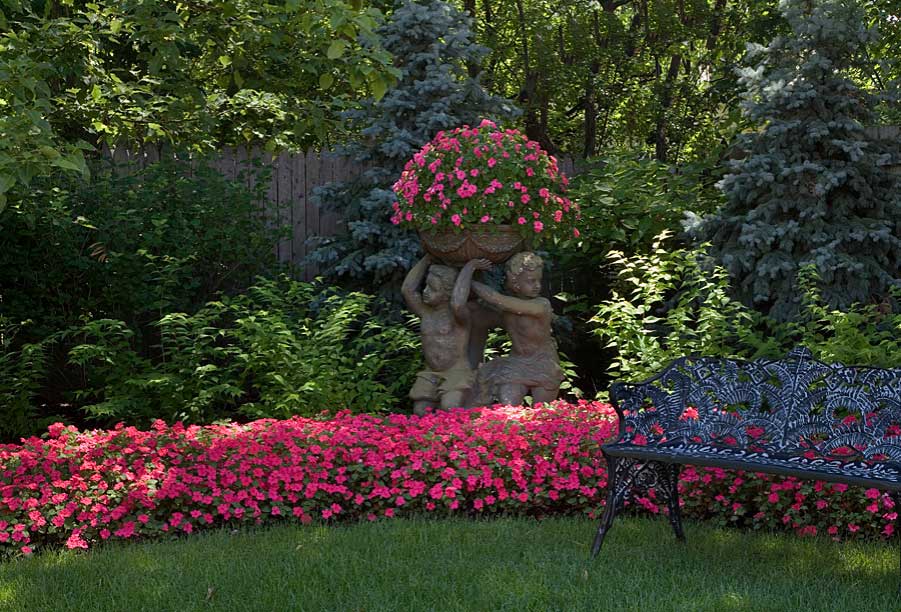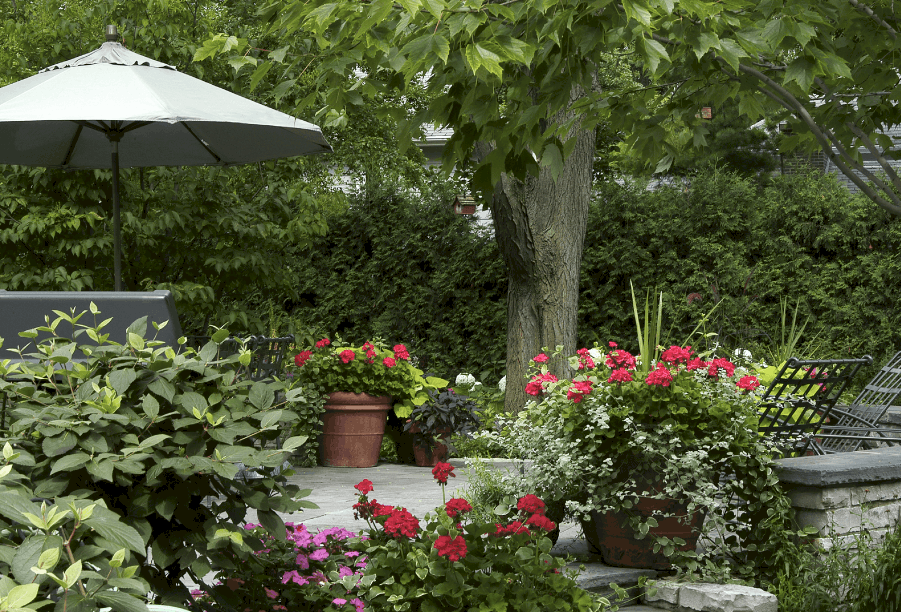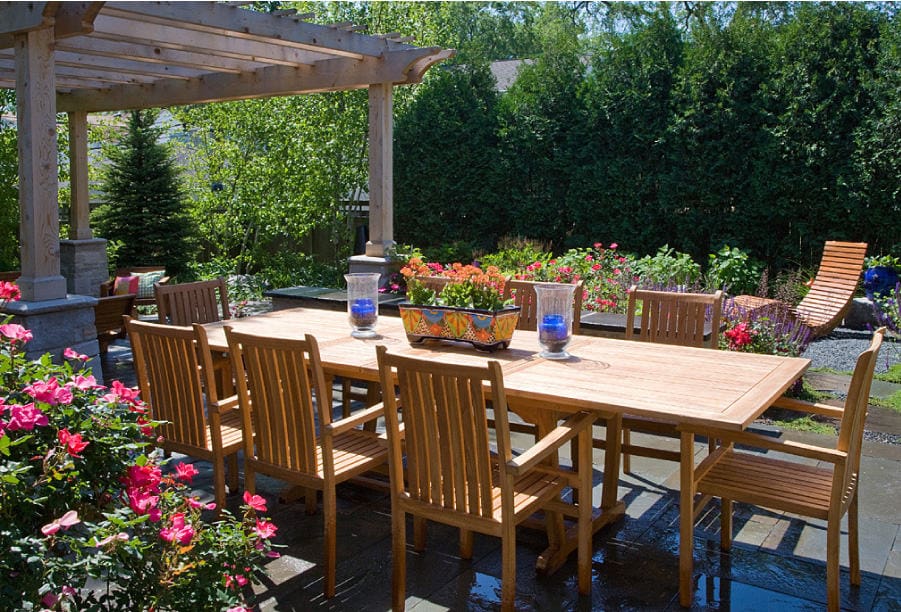Landscaping for Privacy: Living Fences Make Good Neighbors
One homeowner’s definition of privacy may be radically different than another’s — and they’re both accurate. How can this be true? Because like beauty, privacy is in the eye of the beholder. And if fences make good neighbors, then living fences make even better ones! Evergreen trees and fast growing evergreen shrubs create attractive backdrops in the landscape. They also provide seclusion and solitude while allowing butterflies and breezes to travel through.

Landscape Privacy Screens Come in Many Forms
If you’re interested in plants for privacy from neighbors, you’ll be delighted to know that you’ve got a plethora of choices, from barrier privacy to canopies and even dense evergreens. Let’s take a closer look at the different types of privacy landscaping and hardscaping and talk about the steps you should take on your journey to creating your private backyard oasis.
Barrier privacy, both penetrable and impenetrable
Hardscape elements like privacy fences can either be penetrable to allow wind through, or completely solid to offer the maximum level of privacy available. Thick dark green evergreen shrubs, like arborvitae planted close together, can create a green screen in your landscape. Some arborvitae trees can reach nearly 20 feet tall. These barriers offer attractive year-round privacy with little maintenance needed. Not certain what you need? Talk to your Van Zelst landscape architect about the level of privacy you want and we’ll recommend the best barrier solution.
Landscape baffles
Though you may not have heard of the term, you’ve likely seen one—a small screen or partial screen, typically penetrable to allow for free air flow, a baffle is used to add privacy to a specific area; you may see a baffle behind a seating area or serving as a “wall” to denote where the outdoor dining space ends. Van Zelst uses baffles to add privacy and personality to a space; depending on how it is positioned can block a less-than-desirable view while serving as a lovely focal point of its own.
Canopy privacy
There’s nothing like relaxing during a lazy spring or summer day under the shade of a tree, but it’s important that the right trees are planted in the right places so you can maximize your enjoyment. Your tree’s canopy—how far it spreads, how dense it is and how often it sheds its leaves—will have a big impact on the amount of privacy and serenity you’ll be able to enjoy in your yard, so making informed choices is key.  Hearty hedges and shrubs provide year-round privacy, while privacy plants in pots provide coverage and seasonal pops of color.
Hearty hedges and shrubs provide year-round privacy, while privacy plants in pots provide coverage and seasonal pops of color.
Seasonal privacy
When landscaping for privacy, you must think past the warm summer months to ensure your landscape will be able to deliver the seclusion you need, year-round. Evergreen trees, along with hearty hedges and shrubs, will create a base level of privacy that you can count on seven days a week, three hundred sixty-five days a year. Van Zelst knows which plants work well in this area, and which ones don’t (for example, holly) and will help you make informed long-term decisions.
Structural privacy
If you’re thinking about adding another building to your property—a new garage, a greenhouse, a shed or even a playhouse for your children—your Van Zelst landscape architect will urge you to consider the privacy implications before determining its final placement. Adding a new structure creates a unique opportunity for you to resolve an existing privacy issue. Of course, your Van Zelst landscape architect will take into consideration local building codes, setback regulations, etc. but you don’t want to overlook a chance to solve a problem at the same time you’re tackling a new project.  Some of the best evergreen trees for privacy, arborvitae create a dense yet beautiful living privacy screen for this outdoor dining area.
Some of the best evergreen trees for privacy, arborvitae create a dense yet beautiful living privacy screen for this outdoor dining area.
Define Your Privacy Goals
Now that you’re aware of the different types of privacy options available to you, it’s time to focus on mapping out your privacy goals. Think about what you want to achieve. Do you want to block out an unattractive view? Looking for landscaping ideas to block neighbors? Create a cozy dining nook? Or do you have some combination of goals for different areas of your property? Your Van Zelst landscape architect will help you identify and define your goals for your landscape project.
Choose Your Plant Palette
Once your goals are defined, you’ll work with your landscape designer to choose the best plants for a privacy screen that will help you achieve each of your goals. Our team will consider their growth rate and size so that you have a sense as to how long it will take for your landscape to mature into your vision. Van Zelst will choose a mix of hearty evergreens and perennials that add pops of color, as well as allocating appropriate “temporary plants” like verbena or ivy to fill in spaces while slower-growing plants mature to the design intent. Ultimately, your budget and planting access will dictate the size of plants installed—typically, the more mature the plant, the more expensive.
Get the Soil Ready, then Maintain
After selecting the plants, the Van Zelst team prepares the soil. Not only does this mean ensuring the soil has all of the proper nutrients to support the plants’ health, but it also means bringing it up to the proper elevation to increase the planted height of smaller plants, so that the finished look of the landscape turns out as intended. After the initial landscape project is complete, Van Zelst will maintain it, including providing annual fertilization to make sure your garden grows quickly and ensure that all of the plantings reach their full maturity.  Maintaining and fertilizing plants is all part of ensuring that they continue to stay healthy, providing privacy and beauty for years to come.
Maintaining and fertilizing plants is all part of ensuring that they continue to stay healthy, providing privacy and beauty for years to come.
Words of Experience: Rethink Perimeter Plantings
Wondering about the best plants for your fence line or property line? Many clients start out a landscape project wanting to place plantings around the perimeter of their property for privacy, but we often urge them to reconsider this thought as we’ve found it may not be the best option. Instead, we suggest that you consider planting to take advantage of perspective; for example, cutting off the field of view from major windows or gathering areas.